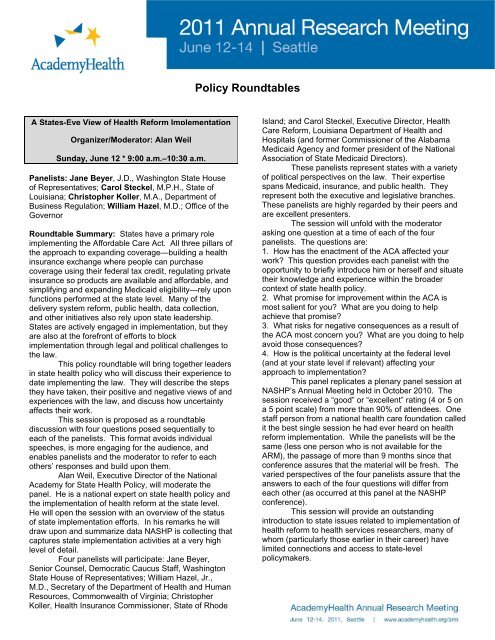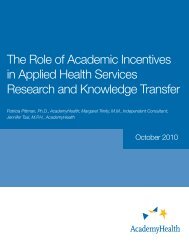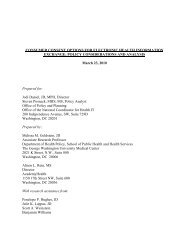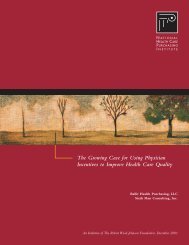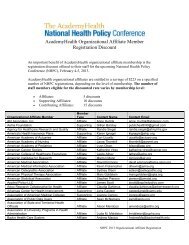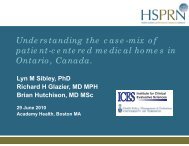Policy Roundtable Abstracts - AcademyHealth
Policy Roundtable Abstracts - AcademyHealth
Policy Roundtable Abstracts - AcademyHealth
You also want an ePaper? Increase the reach of your titles
YUMPU automatically turns print PDFs into web optimized ePapers that Google loves.
<strong>Policy</strong> <strong>Roundtable</strong>s<br />
A States-Eye View of Health Reform Implementation<br />
Organizer/Moderator: Alan Weil<br />
Sunday, June 12 * 9:00 a.m.–10:30 a.m.<br />
Panelists: Jane Beyer, J.D., Washington State House<br />
of Representatives; Carol Steckel, M.P.H., State of<br />
Louisiana; Christopher Koller, M.A., Department of<br />
Business Regulation; William Hazel, M.D.; Office of the<br />
Governor<br />
<strong>Roundtable</strong> Summary: States have a primary role<br />
implementing the Affordable Care Act. All three pillars of<br />
the approach to expanding coverage—building a health<br />
insurance exchange where people can purchase<br />
coverage using their federal tax credit, regulating private<br />
insurance so products are available and affordable, and<br />
simplifying and expanding Medicaid eligibility—rely upon<br />
functions performed at the state level. Many of the<br />
delivery system reform, public health, data collection,<br />
and other initiatives also rely upon state leadership.<br />
States are actively engaged in implementation, but they<br />
are also at the forefront of efforts to block<br />
implementation through legal and political challenges to<br />
the law.<br />
This policy roundtable will bring together leaders<br />
in state health policy who will discuss their experience to<br />
date implementing the law. They will describe the steps<br />
they have taken, their positive and negative views of and<br />
experiences with the law, and discuss how uncertainty<br />
affects their work.<br />
This session is proposed as a roundtable<br />
discussion with four questions posed sequentially to<br />
each of the panelists. This format avoids individual<br />
speeches, is more engaging for the audience, and<br />
enables panelists and the moderator to refer to each<br />
others’ responses and build upon them.<br />
Alan Weil, Executive Director of the National<br />
Academy for State Health <strong>Policy</strong>, will moderate the<br />
panel. He is a national expert on state health policy and<br />
the implementation of health reform at the state level.<br />
He will open the session with an overview of the status<br />
of state implementation efforts. In his remarks he will<br />
draw upon and summarize data NASHP is collecting that<br />
captures state implementation activities at a very high<br />
level of detail.<br />
Four panelists will participate: Jane Beyer,<br />
Senior Counsel, Democratic Caucus Staff, Washington<br />
State House of Representatives; William Hazel, Jr.,<br />
M.D., Secretary of the Department of Health and Human<br />
Resources, Commonwealth of Virginia; Christopher<br />
Koller, Health Insurance Commissioner, State of Rhode<br />
Island; and Carol Steckel, Executive Director, Health<br />
Care Reform, Louisiana Department of Health and<br />
Hospitals (and former Commissioner of the Alabama<br />
Medicaid Agency and former president of the National<br />
Association of State Medicaid Directors).<br />
These panelists represent states with a variety<br />
of political perspectives on the law. Their expertise<br />
spans Medicaid, insurance, and public health. They<br />
represent both the executive and legislative branches.<br />
These panelists are highly regarded by their peers and<br />
are excellent presenters.<br />
The session will unfold with the moderator<br />
asking one question at a time of each of the four<br />
panelists. The questions are:<br />
1. How has the enactment of the ACA affected your<br />
work This question provides each panelist with the<br />
opportunity to briefly introduce him or herself and situate<br />
their knowledge and experience within the broader<br />
context of state health policy.<br />
2. What promise for improvement within the ACA is<br />
most salient for you What are you doing to help<br />
achieve that promise<br />
3. What risks for negative consequences as a result of<br />
the ACA most concern you What are you doing to help<br />
avoid those consequences<br />
4. How is the political uncertainty at the federal level<br />
(and at your state level if relevant) affecting your<br />
approach to implementation<br />
This panel replicates a plenary panel session at<br />
NASHP’s Annual Meeting held in October 2010. The<br />
session received a “good” or “excellent” rating (4 or 5 on<br />
a 5 point scale) from more than 90% of attendees. One<br />
staff person from a national health care foundation called<br />
it the best single session he had ever heard on health<br />
reform implementation. While the panelists will be the<br />
same (less one person who is not available for the<br />
ARM), the passage of more than 9 months since that<br />
conference assures that the material will be fresh. The<br />
varied perspectives of the four panelists assure that the<br />
answers to each of the four questions will differ from<br />
each other (as occurred at this panel at the NASHP<br />
conference).<br />
This session will provide an outstanding<br />
introduction to state issues related to implementation of<br />
health reform to health services researchers, many of<br />
whom (particularly those earlier in their career) have<br />
limited connections and access to state-level<br />
policymakers.
International Insights on Strategies to Disinvest in<br />
Low-Value Healthcare<br />
Organizer/Moderator: Sarah Garner<br />
Sunday, June 12 * 9:00 a.m.–10:30 a.m.<br />
Panelists: Alan Garber, M.D.,Ph.D., Stanford<br />
University; Peter Neumann, Sc.D., Tufts Medical<br />
Center; Adam Elshaug, MPH Ph.D, Agency for<br />
Healthcare Research and Quality; Mark Fendrick, MD;<br />
University of Michigan<br />
<strong>Roundtable</strong> Summary: The substantial overuse, under<br />
use, and misuse of existing medical care is well<br />
documented. A recent Commonwealth Fund survey<br />
indicated that 20% of U.S. community respondents<br />
perceived that in the last 2 years a doctor had<br />
recommended treatment they felt had little or no benefit.<br />
However, to date, international comparative<br />
effectiveness research (CER) and health technology<br />
assessment efforts have primarily focused on new and<br />
emerging technologies and practices. There has been<br />
very little attention on existing – legacy – technologies<br />
that were introduced prior to relatively new stringent<br />
assessment methodologies. Additionally, procedures or<br />
technologies that initially met criteria for safety,<br />
effectiveness (and in many jurisdictions cost<br />
effectiveness) may suffer from ‘indication creep’,<br />
whereby the indications for their use are altered beyond<br />
those originally considered. This may result in the<br />
ineffective use of otherwise effective technologies,<br />
resulting in ineffective care and inappropriate resource<br />
allocation.<br />
There have been a number of historical attempts<br />
to identify and ‘disinvest’ from existing low-value<br />
healthcare, including in the USA: some date back to the<br />
1970s. Most have however not achieved the desired<br />
outcome but for a number of different reasons. Including<br />
a focus on disinvestment from ‘softer’ technologies that<br />
are less politically sensitive for example cosmetic<br />
surgery. Also, attempts were met with criticism due to<br />
perceived process flaws and general resistance from<br />
medical lobby groups and manufacturers. These<br />
experiences now provide important historical insights<br />
regarding design and implementation of disinvestment<br />
strategies and a basis upon which to improve.<br />
The rising costs of healthcare coupled with the<br />
economic crisis have led to current initiatives in<br />
Australia, the United Kingdom, Canada and Spain.<br />
Interest in the US is focused on ‘value-based’ insurance<br />
design as a mechanism for controlling rising healthcare<br />
costs and promoting better healthcare outcomes. Lowvalue<br />
VBID, to discourage the use of low-value<br />
healthcare is being explored and challenges have been<br />
identified. A Federal request for information on the use<br />
of VBID in preventative services has just been released.<br />
While there is a strong economic imperative for<br />
this work for the sake of health system sustainability;<br />
most important, arguably, are the ethical imperative to<br />
patients and the best-practice imperative for purchasers<br />
and providers to deliver high-quality healthcare. A<br />
comprehensive policy approach, therefore, also entails<br />
considerations for how to reinvest or redistribute freed<br />
resources toward healthcare practices, programs and<br />
technologies that allow greater gains in quality and<br />
efficiency.<br />
The challenges of reducing wasteful spending in<br />
health care are shared internationally, but the UK and<br />
Australia have set course for reform into the near-term.<br />
<strong>Policy</strong>makers must transform the vague concept of<br />
‘waste’ into a clearly defined set of targets that can be<br />
more precisely addressed with research and policy.).<br />
This policy roundtable will bring together experts<br />
from the US, Australia and UK to discuss the<br />
experiences and challenges with current initiatives and<br />
highlight the lessons learnt. The Australian and UK<br />
panelists have gained insight into the additional<br />
difficulties with such an agenda in the US through their<br />
Harkness Fellowships, which have focused on low-value<br />
technologies. The discussion will explore the experience<br />
in Australasia, Canada, Europe and North America and<br />
highlight lessons. It will also consider the challenges for<br />
introducing such a policy in the US context. The<br />
opportunities provided by the burgeoning CER agenda<br />
are considered. Solutions are proposed for discussion.<br />
State Exchange on Health Insurance Exchanges<br />
Organizer/Moderator: Anne Gauthier<br />
Sunday, June 12 * 11:00 a.m.–12:30 p.m.<br />
Panelists: Kimberly Belche, Board member, California<br />
Health Benefits Exchange; Joan Henneberry, Director,<br />
Colorado's Exchange Planning grant; Bruce<br />
Greenstein, Secretary, Louisiana's Department of<br />
Health and Hospitals; Jane Cline, West Virginia's<br />
Insurance Commissioner<br />
<strong>Roundtable</strong> Summary: BACKGROUND The Patient<br />
Protection and Affordable Care Act (ACA) calls for the<br />
creation of American Health Benefit Exchanges, which<br />
are expected to be the source of health insurance<br />
coverage for 24 million Americans by 2019. These<br />
exchanges will provide the largest source of new health<br />
coverage and will be the mechanism by which $350<br />
billion worth of federal subsidies for coverage will be<br />
extended to moderate income families and individuals<br />
between 2014 and 2019. Successful development and<br />
operation of the exchanges is critical to achieving the<br />
promise of the ACA. The federal law lays out an<br />
ambitious vision for health insurance exchanges to<br />
perform numerous functions that do not currently exist,<br />
and an equally ambitious timetable for their<br />
development. Although states have the option to let the<br />
federal government run exchanges for them, few are<br />
likely to make this choice given the importance of<br />
coordinating exchanges with all other aspects of health<br />
care, such as Medicaid, insurance regulation, and<br />
population health. Thus, the success or failure of<br />
national health reform depends heavily upon states’<br />
ability to build and operate effective exchanges.
PROPOSED PANEL The panel will feature four<br />
leaders from four very different states: Kimberly Belshe<br />
(CA), Jane Cline (WV), Bruce Greenstein (LA), and Joan<br />
Henneberry (CO). It will be moderated by Anne Gauthier<br />
(NASHP), who will present a short overview of the<br />
critical policy choices states are facing in creating<br />
exchanges. She will then conduct an interactive<br />
discussion among these state policymakers, covering<br />
their diverse approaches in addressing the following key<br />
policy issues in exchange design and implementation:<br />
1)Development of an overall vision for the exchange: To<br />
best take advantage of the tools and flexibility states<br />
have been given through ACA in creating their<br />
exchange, they must first decide what policy goals they<br />
may wish to accomplish with their exchange. An<br />
effective exchange could give meaning to the<br />
affordability standards in the federal law, and could be a<br />
force for efficiency and an orientation toward quality in<br />
the insurance and health delivery sectors. However,<br />
such outcomes do not arise naturally or automatically<br />
from the creation of an exchange. States must be active<br />
and at times aggressive in administering the exchange.<br />
2) Exchange governance structure: The exchange<br />
governance structure – whether a state agency, a quasipublic<br />
agency, or an independent not-for-profit – will<br />
have an important impact on which voices are heard<br />
most clearly when key decisions are made. Furthermore,<br />
the location of a state’s governance structure could have<br />
important implications for how nimble an exchange might<br />
be, the power it will have in leveraging contracts with<br />
both health plans and IT vendors, and how effectively it<br />
can monitor the exchange appeals process. 3) Eligibility<br />
and enrollment: An exchange must be capable of<br />
determining whether a given individual is eligible a<br />
subsidy or is eligible for other programs such Medicaid<br />
and CHIP. States will need to think about how their<br />
populations might transition between programs as their<br />
eligibility for various programs changes over time in<br />
order to ensure the receipt of continuous care. Many<br />
states need to consider the role of county workers and<br />
the interface with social service programs. And the vision<br />
of a first-class customer experience, with as much<br />
reliance on electronic interface as possible, presents<br />
numerous challenges and design options for states. How<br />
the exchange handles transitions of eligibility between<br />
employer-sponsored coverage, exchange coverage and<br />
Medicaid will determine whether consumers received<br />
continuous care from their providers as their income<br />
varies. 4 )Tools to promote affordability: How the state<br />
selects participating health plans will affect how<br />
effectively market forces will be brought to bear to<br />
improve quality and reduce costs. States may span the<br />
spectrum on how involved they may be in regulating plan<br />
participation within the exchange. Some may choose to<br />
have their exchange structured as an open marketplace<br />
where all federally qualified health plans may compete<br />
for their market share. On the other side of the spectrum,<br />
states may leverage their capacity as active purchasers<br />
of health to encourage or reward high value plans.<br />
States will also need to consider implementing riskadjustment<br />
mechanisms and controls for adverse<br />
selection, so that insurance markets will not only be<br />
affordable for even those high health needs, but also<br />
sustainable into the future. 5) Stakeholder engagement:<br />
The decisions that states make about exchanges are<br />
important to a myriad of stakeholders including<br />
consumers, health plans, employers, and health care<br />
providers. Each is likely to have differing views regarding<br />
exchange operations and goals, as well as differing<br />
understanding of how various design choices will affect<br />
them and the health care delivery system. It is important<br />
for states to identify their key stakeholders as well as the<br />
best ways to engage them in order to gain support and<br />
perspective on exchange development.<br />
PANELISTS The panelists bring rich<br />
perspectives and experience to these issues. Anne<br />
Gauthier currently directs several projects at the<br />
forefront of supporting states developing exchanges and<br />
is one of NASHP’s lead staff on interactions with federal<br />
officials on reform implementation. Through her work<br />
under HRSA’s State Health Access Program (SHAP),<br />
she is working with 13 states to expand coverage and<br />
implement reform and led a national webinar with over<br />
500 attendees in a format similar to that proposed here.<br />
She has also been an active participant in the Center for<br />
Consumer Information and Insurance Oversight’s<br />
(formerly OCIIO) early efforts to increase awareness of<br />
critical exchange issues, including, a presentation on<br />
exchange governance structures on OCIIO’s Technical<br />
Assistance Webinar Series in November 2010. She is<br />
also the project director of the recently launched State<br />
Health Exchange Leadership Network, a peer-to-peer<br />
learning community for state officials working on<br />
exchange implementation. In December 2010, Kimberly<br />
Belshé was appointed to the board of California’s newly<br />
established Health Benefits Exchange. Previously, Ms.<br />
Belshé served as Secretary of California’s Health and<br />
Human Service Agency, playing a critical role in the<br />
state’s recent passage of exchange enacting legislation.<br />
Additionally, she serves as chair of the Governor’s Task<br />
Force on Health Care Reform Implementation. Jane L.<br />
Cline is West Virginia’s Insurance Commissioner. In<br />
addition, Ms. Cline serves as President of the National<br />
Association of Insurance Commissioners (NAIC), as well<br />
as Chair of the Management Committee of the Interstate<br />
Insurance Product Regulation Commission. In her role at<br />
the NAIC, she has led the development of model<br />
legislation to implement the Affordable Care Act. Bruce<br />
Greenstein is Secretary of Louisiana’s largest agency,<br />
the Department of Health and Hospitals. Secretary<br />
Greenstein manages a budget of over $8 billion and will<br />
provide oversight and services in mental health, public<br />
health, emergency preparedness, Medicaid, health<br />
information technology, addictive disorders and aging<br />
services. Joan Henneberry was appointed in late 2010 to<br />
lead Colorado’s exchange efforts under the new<br />
governor. She recently left her position under the<br />
previous governor as Executive Director for Colorado’s<br />
Department of Health Care <strong>Policy</strong> and Financing and as<br />
senior health policy advisor to the Governor, developing<br />
and implementing health reform policies and initiatives.<br />
She also spent seven years at the National Governors<br />
Association providing consultation to states on health
care services and financing, cost containment, and<br />
emerging policy issues.<br />
IMPACT These states vary by geography,<br />
political and policy environments, and health care<br />
markets, but the individuals are all leaders in driving<br />
health policy broadly and in thinking through the issues<br />
around developing an exchange. They represent<br />
different positions in state government. They have all<br />
agreed to participate on the panel, but given their key<br />
roles as policymakers, their availability is subject to<br />
change. Clearly, they are forging new ground, and<br />
through this panel they will provide valuable evidence<br />
and expertise on early lessons learned that will go far to<br />
assist all states and policymakers as they move forward<br />
with implementation of health reform.<br />
Identifying, Monitoring, and Evaluating Promising<br />
Payment and Delivery System Innovations<br />
Organizer/Moderator: Stuart Guterman<br />
Sunday, June 12 * 4:30 p.m.–6:00 p.m.<br />
Panelists: Marsha Gold, Sc.D.,M.P.H., Mathematica<br />
<strong>Policy</strong> Research; Lawrence PCasalino, M.D.,Ph.D.,<br />
Weill Cornell Medical College; Randall Brown, Ph.D.,<br />
Mathematica <strong>Policy</strong> Research, Inc.; Paul Wallace, M.D.;<br />
The Permanente Federation, LLC.<br />
<strong>Roundtable</strong> Summary: The national health reform<br />
legislation includes a multitude of new demonstrations<br />
and pilots to cut costs and increase quality in our health<br />
care system. As Atul Gawande notes in his recent<br />
article, “Testing, Testing”, health reform legislation<br />
“contains a test of almost every approach that leading<br />
healthcare experts have suggested” for improving health<br />
care financing and delivery.<br />
One of the principal reasons for why we have<br />
yet to implement the many ideas being proposed to<br />
reform the current delivery system is that we lack<br />
sufficient information on how the proposed<br />
organizational and financing reforms would work in<br />
practice. To address this knowledge gap, the Patient<br />
Protection and Affordable Care Act signed into law in<br />
March 2010 establishes Center for Medicare and<br />
Medicaid Innovation (CMMI) within the Centers for<br />
Medicare and Medicaid Services (CMS). This new<br />
center will facilitate the development of pilot projects and<br />
propose strategies to disseminate and promote the<br />
uptake of successful delivery system reforms. As Stuart<br />
Altman and Robert Mechanic note in a recent article in<br />
the New England Journal of Medicine, a key difference<br />
of demonstrations developed under the Innovation<br />
Center from previous Medicare-sponsored<br />
demonstrations is the Secretary of Health and Human<br />
Services’ new authority to expand pilot programs that<br />
successfully reduce costs or improve the quality of care.<br />
In a recent analysis of the prior challenges that<br />
have arisen when demonstration projects were used to<br />
inform policy, Stuart Guterman and Heather Drake of the<br />
Commonwealth Fund note that prior demonstration<br />
programs were hampered in their ability to move from<br />
testing innovations to their broader application in<br />
practice due to “limitations in the methodology and data<br />
available to conduct comprehensive evaluations of<br />
demonstrations projects” and “insufficient resources for<br />
developing, implementing, monitoring, and evaluating<br />
demonstration projects.” In this session, a panel of<br />
experts with a variety of perspectives will address the<br />
problems identified with moving from the pilot or<br />
demonstration phase to broader program<br />
implementation, including limitations in methods for<br />
assessing and evaluating promising interventions. This<br />
session will include a presentation by Marsha Gold of a<br />
paper she is preparing on this topic, and a panel<br />
discussion of the methodological issues related to<br />
identifying, monitoring, and evaluating promising<br />
payment and delivery system innovations, and the<br />
contribution that the health services research community<br />
can make to this process.<br />
The panel will assess and seek to identify<br />
solutions on the following five critical areas:<br />
1) Criteria used to prioritize innovations that merit an<br />
investment in evaluation and scale up<br />
2) Best practices in the design and implementation of<br />
the pilot intervention itself,<br />
3) Best practices in the design of evaluations<br />
4) Criteria for judging success<br />
5) Strategies for scaling up successful pilots<br />
As Guterman and Drake conclude in their paper, the<br />
success of the Center will depend upon its ability “to<br />
develop reliable methods for monitoring and evaluating<br />
pilot projects and analyzing the applicability of various<br />
aspects of individual pilots for implementation in different<br />
combinations and settings.” Anticipating that<br />
policymakers will need clear direction for meeting the<br />
ambitious goals set for the new CMS Innovation Center,<br />
this project will seek to resolve the inherent conflict<br />
between making quick assessments of promising<br />
innovations and the need to provide compelling evidence<br />
that the project would improve quality and or reduce<br />
cost.<br />
Potential topics for the panel members to discuss<br />
include the following:<br />
What criteria should be considered in selecting an<br />
innovation that merits evaluation<br />
What do we need to keep in mind about the<br />
evaluation design and methods For example:<br />
Should evaluation criteria include both quality and<br />
cost measures<br />
o How is context considered in the<br />
o<br />
design<br />
How do we move beyond randomized<br />
trials to explore relationships of<br />
causality<br />
What constitutes success and when and how should<br />
pilots be scaled up<br />
How do we turn what gets learned from pilots into<br />
system-wide policy<br />
The panel moderator and leader of the discussion will<br />
be: Stuart Guterman, vice president for Payment and<br />
System Reform at The Commonwealth Fund and<br />
executive director of the Fund’s Commission on a High<br />
Performance Health System. The Commission on a High
Performance Health System is charged with promoting a<br />
high-performing health system that provides all<br />
Americans with affordable access to high-quality, safe<br />
care while maximizing efficiency in its delivery and<br />
administration. The Program on Payment and System<br />
Reform supports the analysis and development of<br />
payment policy options that include incentives to<br />
improve the effectiveness and efficiency of health care<br />
delivery while curbing growth in health spending.<br />
Previously, he directed the Centers for Medicare and<br />
Medicaid Services Office of Research, Development,<br />
and Information.<br />
The panelists will include: Marsha Gold, Ph.D., a<br />
senior fellow at Mathematica <strong>Policy</strong> Research in<br />
Washington, DC. She is a nationally known expert on<br />
health care delivery and financing, especially in<br />
managed care and public programs such as Medicare<br />
and Medicaid. Her expertise covers trends in the<br />
organization and financing of medical care and its<br />
implications for access to care.<br />
Lawrence Casalino, M.D., Ph.D., Chief of the<br />
Division of Outcomes and Effectiveness Research and<br />
The Livingston Farrand Associate Professor of Public<br />
Health in the Department of Public Health at Weill<br />
Cornell Medical College. His research focuses on the<br />
organization of physician and hospital practice.<br />
Randall Brown, Ph.D., an expert in health care<br />
policy issues related to care for the chronically ill, longterm<br />
care, managed care, and quality of care. He is<br />
nationally known for his evaluations of care coordination<br />
and disease management programs for Medicare<br />
beneficiaries, as well as studies of long-term care issues<br />
and Medicare managed care.<br />
Paul Wallace, M.D., medical director for Health<br />
and Productivity Management Programs at Permanente<br />
Federation and senior advisor for the Care Management<br />
Institute (CMI) and Avivia Health, the Kaiser Permanente<br />
disease management company established in 2005.<br />
Since 1997, his full-time focus has been administrative<br />
and development endeavors in the application of<br />
evidence-based medicine within disease management,<br />
measurement of clinical performance, technology<br />
assessment, and use of the electronic medical record.<br />
The Ongoing Politics of Health Reform<br />
Organizer/Moderator: Walter Zelman<br />
Monday, June 13 * 8:00 a.m.–9:30 a.m.<br />
Panelists: Walter Zelman, PhD, California State<br />
University, Los Angeles; Mollyanne Brodie, PhD,<br />
Kaiser Family Foundation; Len Nichols, PhD, George<br />
Mason University; Alan Weil, JD; National Academy for<br />
State Health <strong>Policy</strong><br />
<strong>Roundtable</strong> Summary: I propose to offer a policy panel<br />
focused on the ongoing politics of health reform. The<br />
panel will explore the political elements of the ongoing<br />
debate over health reform and the efforts of some to<br />
repeal or alter it and others to defend it and move it<br />
forward. While reform has passed it is clear that the<br />
political struggle around it goes on, with a variety of<br />
efforts underway to undermine or repeal it. While few<br />
expect reform to be repealed in the near term, efforts at<br />
the state and national levels still threaten its<br />
implementation and conceivably, the election of 2012<br />
could be, in large part, a referendum on reform.<br />
Specifically, the panel will look at such factors as<br />
public opinion, support and opposition of activities of<br />
various interest groups, positions of key political and<br />
partisan organizations, and messaging and other<br />
strategies being deployed by reform supporters and<br />
opponents. It will also review those health reform<br />
constructs that are engendering the most controversy<br />
and how the different stakeholder and political<br />
organizations are addressing those issues both in terms<br />
of content and message.<br />
The panel will focus on both federal and state<br />
government activities. At the federal level the panel will<br />
review political activity in both Congressional and<br />
regulatory arenas. The purpose here is not to explore<br />
the substantive proposals at issue. It is assumed that<br />
those will be thoroughly addressed by other ARM<br />
sessions. The purpose here is to look at the political side<br />
of the reform equation: interest group efforts, public<br />
mobilization, electoral considerations, media and<br />
messaging strategies, etc. Specific policy areas may be<br />
addressed, but primarily to the extent that they are being<br />
highlighted by reform opponents or supporters as part of<br />
the larger reform debate, and to the extent that those<br />
policy areas may still be open to a larger negotiation on<br />
reform policy. Looking ahead, the panel will discuss the<br />
role the ongoing health reform debate may assume in<br />
2012 elections.<br />
Regarding health reform politics in the states,<br />
the panel will focus primarily on the efforts of the states<br />
to establish the health reform infrastructure necessary to<br />
implement reform. Most specifically the panel will review<br />
Exchange-focused discussions and activities in the<br />
different states. It will review how political leadership in<br />
the various states –especially governors and<br />
legislators—are approaching the exchange issue. E.g.<br />
are Republican governors taking the view that while they<br />
oppose reform and may fight it in court proceedings they<br />
are still going to support creating the exchange<br />
infrastructure should their efforts to roll back reform fail<br />
Or, are at least some taking the view that the process of<br />
creating (or failing to create exchanges) is part and<br />
parcel of the larger effort to undermine reform To this<br />
end, an effort will be made (data permitting) to compare<br />
the progress being made on the creation of exchanges<br />
in different political environments. As will be the case<br />
with a review of national government activities, the panel<br />
will look at the state level involvement of stakeholder<br />
groups, political leadership, and messaging strategies.<br />
Four individuals have agreed to participate in the<br />
panel discussion. (One more may be added) All have<br />
been deeply involved in the reform process in one way<br />
or another. All are unquestioned experts in the both the<br />
policy and politics of health reform. All have written<br />
extensively on the subject, as researchers and policy<br />
analysts. All are continuing that involvement and that<br />
research.
Moderator Walter Zelman is Chair of the<br />
Department of Health Science , California State<br />
University<br />
MollyAnn Brodie is Director of Public Opinion and<br />
Survey Research at the Kaiser Family Foundation.<br />
Her focus on the panel will be on matters of public<br />
opinion<br />
Len Nichols is the Director of the Center for Health<br />
<strong>Policy</strong> Research and Ethics at George Mason<br />
University. He will focus on national developments,<br />
especially Congressional activity around health<br />
reform opposition or support<br />
Alan Weil is Executive Director of the National<br />
Academy for State Health <strong>Policy</strong>. Alan will provide<br />
particular insight into the efforts of states to<br />
establish the infrastructure for health reform and<br />
the politics of those efforts.<br />
The proposed panel will be a roundtable discussion in<br />
which the moderator will pose questions to panelists.<br />
Initial questions will be asked of individuals, drawing out<br />
their views on the particular expertise they bring to the<br />
subject. Additional questions will be intended inspire<br />
interaction among the panelists. Panelists will be able to<br />
use slides in answering the questions. Panelists will be<br />
given most of the questions in advance so that they may<br />
prepare background information that will be available,<br />
via slides, for sharing with the audience. Audience<br />
participation will be encouraged.<br />
Walter Zelman has moderated several similar panels<br />
at recent ARM conferences. They used similar formats<br />
of roundtable discussion and panel interaction to explore<br />
political themes and issues in health reform. According<br />
to ARM reports and feedback these discussions were<br />
very well received.<br />
Achieving Better Population Health, Better Patient<br />
Experience, and Reducing Cost: Learning from<br />
Variations in Health and Healthcare<br />
Organizer/Moderator: David Radley<br />
Monday, June 13 * 3:00 p.m.–4:30 p.m.<br />
Panelists: Michael Chernew, Ph.D., Harvard Medical<br />
School; Elliott Fisher, M.D., M.P.H., Dartmouth Medical<br />
School; David Kindig, M.D., Ph.D., University of<br />
Wisconsin, Madison; Cathy Schoen, Ph.D.; The<br />
Commonwealth Fund<br />
<strong>Roundtable</strong> Summary: A robust body of evidence<br />
describes unwarranted variations in the healthcare<br />
individuals receive—identifying duplication of services<br />
and the receipt of inappropriate or unsafe care that drive<br />
up costs and put patients at risk. These findings highlight<br />
an important chasm between healthcare spending and<br />
consistent receipt of high-quality healthcare. Other<br />
research points out wide variations in the underlying<br />
health of local populations and calls attention to the<br />
importance of social and environmental determinants of<br />
health. Rising health care costs stress household,<br />
business and public budgets. Efforts to slow cost growth<br />
while improving health outcomes have risen to the top of<br />
the national and local health policy agenda.<br />
Variation in health and healthcare motivates<br />
quality improvement initiatives locally and systematic<br />
reform efforts at regional, state, and national levels.<br />
Such efforts have, to date, focused primarily on cost<br />
control and healthcare quality, often targeting narrowly<br />
defined patient populations or specific processes of care.<br />
With rare exception, improvement efforts generally lack<br />
the explicit goal of improving population health.<br />
Recognizing that health system improvement<br />
efforts require a multidimensional approach, the Institute<br />
for Healthcare Improvement (IHI) developed the Triple<br />
Aim initiative. Its goal is to encourage new system<br />
designs that simultaneously improve the health of the<br />
population, enhance the patient experience when<br />
healthcare services are used (including access, quality,<br />
and reliability), and to reduce—or control—the per capita<br />
cost of healthcare. By pursuing these three objectives in<br />
concert, healthcare systems can identify and more easily<br />
address problems that impede care coordination, lead to<br />
overuse and inefficiency, and direct resources to<br />
activities that have the greatest impact on health.<br />
Without balancing the three objectives of the Triple Aim,<br />
improvement and reform efforts may enhance quality,<br />
but at the expense of cost, or conversely, reduce cost<br />
while alienating patients.<br />
The ability to accurately and effectively measure<br />
each dimension of IHI’s Triple Aim is fundamental to the<br />
success of efforts to improve health system<br />
performance. This roundtable will discuss regional<br />
variations across each of the Triple Aim’s three<br />
dimensions. Special attention will be given to<br />
measurement considerations including the definition of<br />
system-level metrics, the availability of data that allows<br />
local comparisons against standardized inter-regional<br />
benchmarks, and the practical action-oriented use of<br />
data by local improvement integrators. In addition to<br />
metrics, roundtable panelists will discuss efforts to<br />
improve performance and the potential of approaches<br />
that focus on the triple aim of improving population<br />
health, care experiences and slowing cost growth.<br />
This roundtable discussion will be facilitated by<br />
Cathy Schoen, Senior Vice President for <strong>Policy</strong>,<br />
Research and Evaluation at The Commonwealth Fund,<br />
and one of the nation’s foremost experts in health policy<br />
appraisal. The panelists will launch an interactive<br />
discussion with the audience by each offering a short<br />
presentation drawing from their own knowledge and<br />
experience, using evidence from scientific studies, and<br />
current reform initiatives. The roundtable will begin with<br />
three of the panelists each sharing their perspective and<br />
measurement expertise in one dimension of the IHI’s<br />
Triple Aim—cost, the patient experience, and population<br />
health; the fourth panelist will discuss the action-oriented<br />
use of locally representative data to evaluate ongoing<br />
improvement initiatives. Audience members will then be<br />
engaged and asked to share their experience and the<br />
challenges they’ve faced measuring the impact of<br />
improvement in their own work, with the panel providing<br />
direct response to audience questions.
COST: Panelist Michael Chernew, PhD, from<br />
the Harvard Medical School will summarize his research<br />
on differing mechanisms to control healthcare spending<br />
growth while maintaining quality of care. Specifically, Dr.<br />
Chernew will highlight the challenges in collecting and<br />
standardizing cost data, discuss consumer incentives<br />
and value-based insurance design, and discuss how<br />
alternative payment models may align with the goals of<br />
IHI’s Triple Aim initiative.<br />
PATIENT EXPERIENCE: Panelist Elliott Fisher,<br />
MD from The Dartmouth Institute for Health <strong>Policy</strong> and<br />
Clinical Practice will briefly summarize the many lessons<br />
learned from three decades of variation research on<br />
patient outcomes and the patient experience. Dr. Fisher<br />
will give special attention to his landmark findings<br />
illustrating the disconnect between utilization volume and<br />
patient outcomes and the implications of unwarranted<br />
variations for patient safety and quality of care. He will<br />
conclude by discussing the potential of newly proposed<br />
initiatives to stimulate and support accountable delivery<br />
systems.<br />
POPULATION HEALTH: Panelist David Kindig,<br />
MD, PhD from the University of Wisconsin School of<br />
Medicine and Public Health will draw on his experience<br />
as co-director of CountyHealthRankings.ORG and the<br />
Mobilizing Action Toward Community Health (MATCH)<br />
project to discuss measurement of the social and<br />
environmental determents of health and their interaction<br />
with the healthcare system when quantifying the health<br />
of a population. He will also discuss the synergies and<br />
conflicts between conceptualizations of population health<br />
in the Triple Aim and MATCH models.<br />
PERFORMANCE MEASUREMENT: Panelist<br />
David Radley, PhD, is a measurement expert at the<br />
Institute for Healthcare Improvement and The<br />
Commonwealth Fund. Dr. Radley will draw on real-world<br />
examples (based on IHI collaborations with<br />
organizations currently pursuing improvement activities<br />
around the Triple Aim concepts) to discuss the unique<br />
challenges of simultaneously measuring performance<br />
across the three dimensions of the Triple Aim. He will<br />
describe his experience creating locally representative<br />
health system performance scorecards and will discuss<br />
the collection and use of systematically defined ‘local’<br />
data to measure health system performance and<br />
motivate improvement.<br />
Healthcare system design and re-design should<br />
simultaneously aim to improve population health,<br />
enhance the patient experience, and reduce per capita<br />
healthcare spending. Proposed and legislated<br />
healthcare reforms can go a long way to achieving better<br />
performance on each of these dimensions. However,<br />
success also requires the development of data systems<br />
and carefully defined metrics that are accessible to<br />
evaluators, a recognition of and commitment to<br />
addressing the community-based determinants of<br />
population health, a common purpose and the adoption<br />
of mechanisms to control per capita cost, and most<br />
importantly, engagement from motivated local entities<br />
that are willing and able to support a defined population<br />
and ensure the existence of systems that align<br />
healthcare services with individual’s needs.<br />
Reducing Readmissions: Practice, Payment, or Pot<br />
of Coffee<br />
Organizer/Moderator: Amy Boutwell<br />
Monday, June 13 * 4:45 p.m.–6:15 p.m.<br />
Panelists: Arnold Epstein, M.D., M.A., Harvard<br />
University; Jane Brock, M.D., M.P.H., Colorado<br />
Foundation for Medical Care; John Young, Centers for<br />
Medicaid and Medicare Services<br />
<strong>Roundtable</strong> Summary: Hospital readmissions are of<br />
major policy interest because they occur frequently, vary<br />
across settings, and offer the potential to simultaneously<br />
reduce spending and improve patient outcomes. In<br />
recent years clinical leaders and policy makers have<br />
tried many approaches to reducing readmissions. Some<br />
of these efforts are directed at quality of care during and<br />
after discharge and focus on improving discharge<br />
planning, assuring timely follow up and providing better<br />
transitional care. Other efforts focus more generally on<br />
ambulatory care and seek to provide better disease<br />
management and improved coordination of care. More<br />
recently there has been interest in changing the<br />
underlying incentives for using hospital services. The<br />
Center for Medicare and Medicaid Services is planning<br />
to initiate programs to "bundle" payment for all the<br />
services around a hospitalization, and to provide shared<br />
savings for accountable care organizations. This <strong>Policy</strong><br />
<strong>Roundtable</strong> will bring together policy makers, clinical<br />
leaders and researchers to describe and discuss<br />
ongoing and future efforts to reduce unnecessary<br />
readmissions. The four speakers and the topics that they<br />
will cover are described below.<br />
Arnold M. Epstein, Chair, Department of Health<br />
<strong>Policy</strong> and Management, Harvard School of Public<br />
Health. Dr Epstein will describe recent research<br />
examining the variation in rates of readmission across<br />
different Hospital Referral Regions (HRRs) as identified<br />
in the Dartmouth Atlas and the factors that explain this<br />
variation. Dr. Epstein and his collaborators found that<br />
rates of readmission within 30 days after index<br />
hospitalization for congestive heart failure or pneumonia<br />
vary more than three fold from 11% to 35%. The most<br />
important factor explaining readmissions is the<br />
propensity to hospitalize as measured by the population<br />
based all-cause admission rate in the HRR which<br />
explained roughly 35% of the variance in 30, 60 and 90<br />
day readmissions. Bed supply was also important.<br />
Comorbidity (the 29 co-morbidities in the Elixhauser<br />
schema), measures of discharge planning (as<br />
ascertained by the hospital version of the Consumer<br />
Assessment of Health Plans Survey (H-CAHPS) data)<br />
and other supply side factors (number of primary care<br />
physicians, and number of specialists in cardiovascular<br />
or pulmonary medicine per 100,000 persons in each<br />
HRR) explain little of the regional variation.<br />
These findings underscore the importance of<br />
general propensity to hospitalize patients and the<br />
number of beds available. <strong>Policy</strong> initiatives designed to<br />
lower the propensity to use hospital services may be
even more successful in reducing readmissions than<br />
many of the delivery system programs initiated to date.<br />
Amy E. Boutwell, Director of Health <strong>Policy</strong><br />
Strategy, Institute for Healthcare Improvement. Dr.<br />
Boutwell will describe the STAAR (STate Action on<br />
Avoidable Rehospitalizations) initiative, a<br />
Commonwealth Fund supported project of the Institute<br />
for Healthcare Improvement. The aim of the STAAR<br />
initiative is to reduce rehospitalizations, and identifies the<br />
state as the unit of intervention.<br />
Dr. Boutwell will discuss the two-part, parallel<br />
strategy of the STAAR initiative: to support front-line<br />
process improvements in transitions of care and to<br />
leverage state-level multi-stakeholder leadership<br />
engagement to accelerate improvement at a regional<br />
level. STAAR provides technical assistance and<br />
strategic guidance to state-level steering committees<br />
which are tackling state-wide measurement issues,<br />
optimizing provider engagement in complementary<br />
payer-based initiatives, and initiating community-specific<br />
efforts to address pressing social challenges which<br />
contribute to hospital utilization.<br />
In addition, Dr Boutwell will discuss a unique<br />
element of the STAAR initiative: the cross-continuum<br />
team. Partnering hospital teams with community-based<br />
providers and non-clinical support services has been<br />
one of the most readily adopted recommendations in the<br />
program. Working as a cross-continuum team in a<br />
voluntary quality improvement initiative create a<br />
foundation for organizations in communities to take the<br />
“first steps” in the transitional phase between today’s<br />
practice and payment realities and the proposed models<br />
of a future state.<br />
Jane Brock, Medical Officer, Colorado<br />
Foundation for Medical Care and Clinical Lead,<br />
Transitions of Care Program Sub-national Theme. Dr<br />
Brock will describe the results and lessons to date<br />
resulting from the CMS QIO sub-national theme on<br />
Transitions of Care, a three-year project to improve care<br />
transitions and reduce rehospitalizations among<br />
Medicare beneficiaries in 14 geographically-defined<br />
communities throughout the US, covering approximately<br />
1.25 million beneficiaries. The Care Transitions Project<br />
is unique in adopting a geographically defined patient<br />
population as the unit of interest. Dr Brock will describe<br />
the common and unique models of care that are being<br />
implemented in the 14 communities, and what the<br />
project is learning about successful strategies. In some<br />
cases, the most successful strategy to improve care<br />
transitions in a community was “providing a box of<br />
doughnuts and a pot of coffee!”<br />
Dr. Brock will share the midterm results of the<br />
project, including Medicare utilization savings as a result<br />
of averted hospitalizations of $100 million. Key<br />
measurement issues will be described, including the<br />
rationale behind abandoning the original measure was %<br />
of all discharges that were readmitted in favor of a<br />
readmission incidence measure. Implementation and<br />
sustainability issues from the field will be described.<br />
John Young, Senior Advisor to the Acting<br />
Director, Center for Medicare & Medicaid Innovation<br />
(CMMI), Office of the Administrator (OA), Center for<br />
Medicare & Medicaid Services (CMS). Mr Young is<br />
responsible for advising the Center for Medicare &<br />
Medicaid Innovation (CMMI) acting director on creating<br />
national coherency across the identification, evaluation,<br />
and diffusion of care redesign and bundled payment<br />
approaches through Accountable Care Organizations<br />
(ACO) and Medical Homes for Medicare and Medicaid<br />
beneficiaries. Mr Young will describe bundled payment<br />
approaches as conceptualized by CMS, and will relate<br />
the findings of Dr Epstein’s research and Drs Boutwell<br />
and Brocks’ implementation experiences to the system<br />
redesign goals intended by payment policy reforms.<br />
Constitutional Challenges to Health Care Reform<br />
Organizer/Moderator: Mark Hall<br />
Monday, June 13 * 4:45 p.m.–6:15 p.m.<br />
Panelists: Ken Wing, University of Washington;<br />
Timothy Stoltzfus Jost, J.D., Washington and Lee<br />
University; Mark Hall, J.D., Wake Forest University<br />
<strong>Roundtable</strong> Summary: Lawsuits challenging the<br />
constitutionality of the Affordable Care Act (ACA)<br />
threaten to overturn health insurance reform. Almost half<br />
the states have filed suit, in addition to a dozen or more<br />
suits by private individuals, provider groups, or public<br />
interest organizations. To date, two federal judges have<br />
upheld the ACA, one has struck down the individual<br />
mandate, and another has expressed considerable<br />
skepticism about the mandate’s constitutional validity.<br />
These, and other decisions that will likely be issued by<br />
the time of the conference, will be appealed to various<br />
circuit courts of appeal, and eventually to the Supreme<br />
Court.<br />
If some or all of the Affordable Care Act is<br />
declared unconstitutional, this obviously will have<br />
seismic impact on health policy. If the individual<br />
mandate, which is the main target, is stricken in<br />
isolation, the remaining insurance regulations could<br />
wreak market havoc, due to adverse selection. For that<br />
and other reasons, finding this major provision<br />
unconstitutional might sink much or all of the law, if a<br />
court were to invalidate all related provisions. Moreover,<br />
states challenge the constitutionality of requirements to<br />
expand Medicaid and to implement insurance<br />
exchanges.<br />
Also critical is to understand how long it will take<br />
courts to resolve these issues. Although the ACA’s major<br />
provisions do not take effect until 2014, litigation often<br />
takes several years, and looming uncertainty could be<br />
very disruptive to state and federal implementation<br />
efforts, and to anticipatory measures by market<br />
participants.<br />
This roundtable panel will explain the major<br />
components of this litigation, the likely procedural stages<br />
and timing, and the bases on which courts can be<br />
expected to rule. This will provide the audience a more<br />
informed foundation from which to interpret and<br />
anticipate unfolding legal events and their policy<br />
impacts. The presenters and their topics will be:
Timothy Jost, J.D., Washington and Lee<br />
University, will provide an overview of the various suits,<br />
their basic claims, and their likely progress through the<br />
courts.<br />
Mark A. Hall, J.D., Wake Forest University, will<br />
address the Commerce Clause challenges to the<br />
individual mandate, and the market consequences if the<br />
mandate is declared invalid.<br />
Ken Wing, J.D., Seattle Univ. and Univ. of<br />
Washington, emeritus, will address the political<br />
implications of these challenges, as well as constitutional<br />
arguments regarding individual rights.<br />
Also invited will be the Washington State<br />
Attorney General or a representative from his office,<br />
which is one of the suing states, to discuss claims that<br />
the ACA violates states’ sovereign rights.<br />
Implementing Electronic Health Records<br />
Organizer/Moderator: Melinda Beeuwkes Buntin<br />
Tuesday, June 14 * 8:00 a.m.–9:30 a.m.<br />
Panelists: Peggy Evans, Ph.D, Washington & Idaho<br />
Regional Extension Center for Health Information<br />
Technology; Eric Jamoom, National Center for Health<br />
Statistics; Vaishali Patel, Office of the National<br />
Coordinator for Health Information Technology; Mary<br />
Rubino, Health Affairs<br />
<strong>Roundtable</strong> Summary: By June 2011, thousands of<br />
providers will have received Medicare or Medicaid<br />
incentive payments for the “meaningful use” of electronic<br />
health records (EHRs). Many more will still be deciding<br />
whether or not to purchase an EHR or working to<br />
implement and use their EHR. In order to realize the<br />
goal of a health care system powered by information<br />
technology set out in the Health Information Technology<br />
for Economic and Clinical Health (HITECH) Act in 2009,<br />
providers will need information and assistance in<br />
choosing, implementing, and fully using an EHR. Only<br />
when a critical mass of providers have successfully<br />
implemented EHRs can the vision of a health care<br />
system in which data follows patients and seamlessly<br />
informs clinical decision-making be realized. Participants<br />
in this <strong>Policy</strong> <strong>Roundtable</strong> will discuss the latest data on<br />
EHR adoption, including success stories and areas that<br />
require policy attention, policies and strategies to boost<br />
EHR adoption and improve implementation, real-world<br />
examples of EHR implementations, and gaps in our<br />
understanding of the challenges of EHR implementation,<br />
from the viewpoint of multiple stakeholders. Vaishali<br />
Patel PhD, senior researcher at ONC, will provide an<br />
overview of what is known about the current status of<br />
electronic health records adoption. She will highlight<br />
areas of success, including the recent jump in adoption<br />
among primary care physicians, and groups which are<br />
lagging such as rural and critical access hospitals. Her<br />
comments will draw on the latest data from national<br />
surveys of physicians and hospitals and from new data<br />
available to ONC on electronic prescribing patterns. Dr.<br />
Patel has published extensively on consumer attitudes<br />
towards electronic health records and health information<br />
exchange and will also comment on how these factors<br />
affect the climate for adoption. David Blumenthal MD<br />
MPP, the National Coordinator for HIT, will provide an<br />
overview of federal strategies to promote the meaningful<br />
use of electronic health records. These include both the<br />
Medicare and Medicaid incentive programs and ONC’s<br />
own grant programs. ONC’s Regional Extension Center<br />
Program offers providers hands-on technical assistance,<br />
guidance and information on best practices to support<br />
and accelerate health care providers’ efforts to become<br />
meaningful users of Electronic Health Records (EHRs).<br />
The extension centers are focusing efforts on primary<br />
care providers in smaller and safety-net practices and on<br />
critical access hospitals. The Beacon Community<br />
Grantees aim to demonstrate the vision of a future<br />
where hospitals, clinicians, and patients are meaningful<br />
users of health IT, and together the community achieves<br />
measurable improvements in health care quality, safety,<br />
efficiency, and population health. State Health<br />
Information Exchange Cooperative Agreement Program<br />
supports States or State Designated Entities (SDEs) in<br />
establishing health information exchange capability<br />
among healthcare providers and hospitals in their<br />
jurisdictions. ONC also supports a comprehensive<br />
workforce program including a Community College<br />
Consortia to educate Health Information Technology<br />
professionals, university-based training, curriculum<br />
development, and competency testing. Dr. Blumenthal<br />
will discuss the principles that guided the development of<br />
the meaningful use criteria and ONC’s constellation of<br />
grant programs. He will also report on the progress<br />
made by grantees and the challenges they are facing.<br />
Peggy Evans, PhD, CPHIT, Director of the Washington<br />
& Idaho Regional Extension Center (WIREC) for<br />
Health Information Technology, will provide insights from<br />
her perspective on the ground assisting providers in the<br />
northwest with successfully adopting electronic health<br />
records (EHRs) and reaching meaningful use. Dr. Evans<br />
will describe the strategies being used by WIREC to<br />
provide education, outreach, and direct assistance. Dr.<br />
Evans has testified before the House Energy and<br />
Commerce Committee on the implementation and use of<br />
EHRs and is an executive with Qualis Health, a private,<br />
not-for-profit healthcare consulting and quality<br />
improvement organization based in Washington State.<br />
Eric Jamoom PhD, a fellow at the National Center for<br />
Health Statistics will discuss the new national physician<br />
survey related to EHR implementation that will be<br />
entering the field in summer 2011. The new Physician<br />
Workflow Study represents a data collection initiative by<br />
ONC and NCHS to better understand physician<br />
experiences with EHR adoption and use. The study will<br />
follow 3 cohorts of physicians from the 2011 EMR Mail<br />
Supplement to the National Ambulatory Medical Care<br />
Survey (NAMCS) at various levels of EHR adoption over<br />
a 3 year period from 2011 to 2013. The main purpose of<br />
the study is to obtain information related to the costs,<br />
benefits, and barriers related to the use of electronic<br />
health records at various stages of adoption. This<br />
information will help ONC target and refine the strategies<br />
of its grantees, understand and communicate the
experiences of adopters, measure progress towards<br />
HITECH program goals, and develop policies for the<br />
second stage of meaningful use criteria effective in<br />
2013. Susan Dentzer is the Editor-in-Chief of Health<br />
Affairs, the nation's leading journal of health policy, and<br />
an on-air analyst on health issues with The NewsHour<br />
with Jim Lehrer on the Public Broadcasting Service<br />
(PBS). Ms. Dentzer will round out the panel by<br />
discussing the key questions she hears about electronic<br />
health records from policymakers, providers, and other<br />
stakeholders and the role that she sees digitalized health<br />
information playing in a reformed health delivery system.<br />
The panel will be chaired by Melinda Beeuwkes Buntin<br />
PhD, Director of the Office of Economic Analysis and<br />
Modeling within the Office of the National Coordinator for<br />
Health Information Technology (ONC) at HHS. She will<br />
introduce the panelists, give them each 10 minutes to<br />
deliver introductory remarks, and then ask them a series<br />
of questions including: • What is the biggest challenge<br />
providers face when deciding whether or not to adopt an<br />
EHR What additional policies might help them address<br />
that challenge • If you could go back and add one<br />
provision to the HITECH Act what would it be and why<br />
What might it cost • Research on health information<br />
technology is expanding rapidly. What is the most useful<br />
finding you’ve seen from the research community this<br />
year What would you like to know more about<br />
Geographic Equity in Medicare Payment <strong>Policy</strong>:<br />
Geographic Adjustment Factors and Value-Based<br />
Health Care<br />
Organizer/Moderator: Margo Edmunds<br />
Tuesday, June 14 * 8:00 a.m.–9:30 a.m.<br />
Panelists: Jon Christianson, Ph.D., University of<br />
Minnesota School of Public Health; Stuart Guterman,<br />
M.A., The Commonwealth Fund; Carlos Jaen, M.D.,<br />
Ph.D., University of Texas Health Science Center at San<br />
Antonio; Marilyn Moon, Ph.D., American Institutes for<br />
Research; Thomas Ricketts, Ph.D., University of North<br />
Carolina, Chapel Hill<br />
<strong>Roundtable</strong> Summary: Medicare payments to<br />
physicians and hospitals are adjusted by geographic<br />
location, recognizing that some costs beyond the<br />
providers’ control vary in urban and rural areas and<br />
different parts of the country. Geographic adjustment is<br />
intended and designed to create a fee structure that<br />
compensates providers at the same real rate across the<br />
country. Before the Patient Protection and Affordable<br />
Care Act was passed, several members of Congress,<br />
policy experts, and clinical practitioners actively debated<br />
the need for an adjustment and the equity of the<br />
geographic adjustments for urban and rural areas and<br />
the data and methods used to calculate them.<br />
By Medicare statute, geographic adjustments<br />
must be budget-neutral, which forces a zero-sum game<br />
in which any adjustment upward for one provider or<br />
group of providers must be paid for by a downward<br />
adjustment to one or more other providers. Because<br />
there is no consensus in the provider community or<br />
among policy-makers on how to best adjust payments<br />
based on geographic location, The Secretary of Health<br />
and Human Services (HHS) and Congress sought<br />
advice from the Institute of Medicine (IOM) on how best<br />
to address stakeholders’ concerns as the new health<br />
care reform legislation is being implemented.<br />
The IOM study was commissioned to evaluate<br />
the accuracy of the adjustment factors and the<br />
methodology used to determine them, including the<br />
timeliness and accuracy of the sources of data used and<br />
their representativeness of operational costs of<br />
providers. The IOM was also asked to assess the effect<br />
of the adjustment factors on the level and distribution of<br />
the healthcare workforce and providers’ ability to provide<br />
high-value care, and the resulting impact on Medicare<br />
beneficiaries’ access to care.<br />
The participants in this policy roundtable will<br />
discuss the technical approach, findings, and<br />
recommendations of the IOM study’s first report to<br />
Congress and the Secretary of HHS, which will be<br />
released in May 2011. The participants include the<br />
study director and five members of the expert committee<br />
convened by the IOM to conduct the study. Their areas<br />
of expertise include health economics, health policy<br />
analysis, primary care, rural healthcare, geographic<br />
variation, healthcare workforce, and policy development<br />
and implementation.<br />
The study director, Margo Edmunds, PhD, will<br />
serve as moderator. Dr. Edmunds is a health policy<br />
analyst with a clinical background in disease<br />
management. She will provide a brief background on<br />
the scope and methods of the study and will introduce<br />
the IOM committee members who will serve as<br />
panelists.<br />
Marilyn Moon, PhD, is a health economist,<br />
Senior Vice President and Director, Health at the<br />
American Institutes for Research, and former Trustee for<br />
the Medicare trust fund. Dr. Moon will provide<br />
background on the Medicare payment structure for<br />
physicians and hospitals and describe the committee’s<br />
approach to evaluating data accuracy for the Hospital<br />
Wage Index.<br />
Stuart Guterman, MA, is Vice President,<br />
Payment and System Reform, and Executive Director for<br />
the Commission on a High Performance Health System<br />
at The Commonwealth Fund, and is a health economist<br />
with extensive experience in health care financing and<br />
payment systems. He will describe the committee’s<br />
recommendations about geographic payment localities<br />
and labor markets and their implications for urban and<br />
rural payment equity.<br />
Jon Christianson, PhD, Professor and James A.<br />
Hamilton Chair in Health <strong>Policy</strong> and Management at the<br />
University of Minnesota School of Public Health, is a<br />
health economist with expertise in health insurance,<br />
healthcare markets, and tracking change in healthcare<br />
markets. Dr. Christianson will describe the committee’s<br />
approach to impact analysis and the study’s implications<br />
for value-based healthcare delivery.<br />
Carlos Jaen, MD, PhD, is Professor of<br />
Epidemiology and Biostatistics, Co-Director of the
Center for Research in Family Medicine and Primary<br />
Care, and a practicing family physician at the University<br />
of Texas Health Science Center at San Antonio. Dr.<br />
Jaen will discuss the impact of the committee’s<br />
recommended changes in physician payment policies on<br />
primary care.<br />
Thomas Ricketts, PhD, is Professor of Health<br />
<strong>Policy</strong> and Management at the University of North<br />
Carolina Gillings School of Global Public Health. In<br />
October 2010, Dr. Ricketts was appointed to the<br />
National Health Care Workforce Commission created by<br />
the Patient Protection and Affordable Care Act. An<br />
expert in rural hospitals and health care access, Dr.<br />
Ricketts will discuss the implications of the committee’s<br />
recommendations for workforce distribution in rural and<br />
urban areas.<br />
The format for the roundtable will be interactive<br />
and will allow ample time for questions from members of<br />
the audience. Each presenter will offer a 5-7 minute<br />
statement summarizing key components of the study<br />
and recommendations from their perspective and area of<br />
expertise. Individual presentations will be followed by a<br />
Q and A led by the moderator and highlighting how the<br />
committee addressed conflicting stakeholder<br />
perspectives, such as whether the true costs of health<br />
care are recognized in high-cost urban areas and lowcost<br />
rural areas; whether the contributions of rural<br />
providers are undervalued or overvalued compared to<br />
those in urban areas; whether the occupational mix of<br />
clinical staff used for geographic adjustment is<br />
comparable in urban and rural areas; and whether socalled<br />
policy adjustments such as Graduate Medical<br />
Education or Health Professional Shortage Areas are<br />
accurate and fair.<br />
Health Information Exchange: Federal, State, and<br />
Local Perspective<br />
Organizer/Moderator: Ashish Jha<br />
Tuesday, June 14 * 9:45 a.m.–11:15 a.m.<br />
Panelists: David Blumenthal, M.D., M.P.P.,<br />
Department of Health and Human Services; Rachel<br />
Block, New York State Department of Health; Richard<br />
Rubin, OneHealthPort; Julia Adler-Milstein, Harvard<br />
University<br />
<strong>Roundtable</strong> Summary: Health information exchange<br />
(HIE) is a central component of Meaningful Use of<br />
Electronic Health Records (EHRs), the criteria used by<br />
the U.S. government to pay incentives to providers and<br />
hospitals under the Health Information Technology for<br />
Economic and Clinical Health (HITECH) Act. Several<br />
models suggest that broad-based HIE could result in<br />
large financial savings and these projections have<br />
served to promote HIE alongside EHR adoption. Under<br />
the Bush administration, funding was made available to<br />
support local and regional HIE efforts. However,<br />
enabling the flow of key clinical data, both among<br />
providers and among providers and other stakeholders,<br />
was fraught with challenges. While some efforts were<br />
successful in facilitating clinical data exchange, few<br />
supported comprehensive exchange among all<br />
stakeholders in the region. In addition, many efforts<br />
were unable to find sustainable business models,<br />
address legal and regulatory barriers, or negotiate<br />
complex technical solutions, and as a result, they<br />
ultimately failed.<br />
HITECH reignited momentum behind HIE with<br />
both a clear business case in the form of incentives to<br />
doctors and hospitals to engage in exchange, and a new<br />
infusion of financial support to the entities facilitating<br />
exchange of data. Under the State HIE Cooperative<br />
Agreement Program administered by the Office of the<br />
National Coordinator for Health IT (ONC), funding is<br />
being awarded to states and state-designated entities to<br />
build out HIE capabilities. A total of $548 million in<br />
funding will be given to 56 states, eligible territories, and<br />
qualified State Designated Entities (SDE), and awardees<br />
are responsible for increasing the level of<br />
interoperability, enabling patient-centric information flow<br />
in order to improve the quality and efficiency of care.<br />
This requires that states put in place governance,<br />
policies, technical services, business operations, and<br />
financing mechanisms for HIE over the four-year<br />
performance period.<br />
While the goals of the program are clear, states<br />
still have substantial latitude in deciding how to fulfill<br />
them. States can therefore choose to have no direct role<br />
in the provision of HIE, or, on the other extreme, be the<br />
only provider of HIE services, directly connecting to all<br />
the relevant stakeholders. The benefit of a state-centric<br />
approach is greater flexibility in designing an HIE<br />
strategy that can take into account state-specific<br />
differences in the legal/regulatory environment, the<br />
structure of the health care delivery market and any<br />
existing efforts to establish HIE. However, many of the<br />
same challenges faced by local and regional HIE efforts<br />
are likely to be encountered by states, and so it remains<br />
to be seen how successful states will be in increasing<br />
the flow of clinical data between health care<br />
stakeholders.<br />
Our policy roundtable will provide a multi-level<br />
perspective on the current approach to achieving<br />
nationwide HIE. The moderator, Dr. Ashish Jha, an<br />
associate professor at the Harvard School of Public<br />
Health and national expert on health IT and HIE, will<br />
open with the background and motivation for the panel.<br />
Next, Dr. David Blumenthal, the National Coordinator for<br />
Health IT, will provide an overview of the current federal<br />
approach. We will then have representatives from two<br />
states, Rachel Block of New York and Rick Rubin of<br />
Washington, present their plans. This will be followed by<br />
Julia Adler-Milstein who will present recent survey data<br />
on the progress of local and regional HIE efforts across<br />
the U.S. We will conclude with a discussion of key<br />
challenges that lie ahead, facilitated by Dr. Jha. We<br />
describe the individual topics covered by each panelist<br />
below.<br />
David Blumenthal: In his role as National<br />
Coordinator for Health IT, Dr. Blumenthal was a principal<br />
contributor to developing the State HIE Cooperative<br />
Agreement Program. He will describe the goals,
structure, and evaluation of the program in detail as well<br />
as how the program fits with the broader goals of<br />
HITECH. He will also discuss the key policy and<br />
implementation challenges to successfully achieving<br />
nationwide HIE.<br />
Rachel Block: As the HIT Coordinator for the<br />
state of New York, Rachel is one of the leaders working<br />
to formulate the HIE plan under the State Cooperative<br />
Agreement Program. New York has a long HIE history<br />
and devoted substantial funding to support HIE prior to<br />
HITECH. As a result, they have more than 10<br />
operational exchanges covering all counties in the state.<br />
They have therefore chosen to pursue a statewide<br />
approach, called SHIN-NY, based on a set of agreed<br />
upon protocols, standards, and policies which, when<br />
adopted by regional and local exchanges and other<br />
entities, will allow clinical data exchange across their<br />
systems. As a state on the forefront of HIE capabilities,<br />
Rachel will discuss the New York experience as well as<br />
offer insights into the key challenges they encountered<br />
and how they were addressed.<br />
Rick Rubin: Rick is the CEO of OneHealthPort,<br />
the private sector partner selected by the state of<br />
Washington to serve as the lead HIE organization. In<br />
this capacity, OneHealthPort will implement the primary<br />
HIE infrastructure and related services. Known as “the<br />
Hub”, the Washington state model is making available a<br />
service for routing messages containing clinical<br />
information between providers and other health care<br />
stakeholders who register to send and receive<br />
messages (“trading partners”). Rick will provide more<br />
details about the model, share the rationale for pursuing<br />
this approach, and discuss the key challenges they face.<br />
He will also discuss how this approach works in parallel<br />
with existing HIE efforts as well as other HITECH<br />
initiatives such as the Beacon Community.<br />
Julia Adler-Milstein: Julia Adler-Milstein is a<br />
national expert on local and regional HIE efforts. She<br />
has conducted three national surveys tracking the<br />
progress of these organizations as well as studied key<br />
facilitators of, and barriers to, their success. She will<br />
present her most recent survey data on the status of<br />
local and regional efforts, and describe the role of these<br />
efforts in state plans. She will also discuss key<br />
challenges faced by local HIE efforts and potential<br />
strategies that can be used by states to engage<br />
providers and other stakeholders in HIE.<br />
The Affordable Care Act and Long-Term Care:<br />
Meaningful Reform or Just Tinkering Around the<br />
Edges<br />
Organizer/Moderator: Edward Miller<br />
Tuesday, June 14 * 9:45 a.m.–11:15 a.m.<br />
Panelists: Terence Ng, J.D., University of California<br />
San Francisco; Charles Phillips, Ph.D., M.P.H., Texas<br />
A&M University System Health Science Center; Robyn<br />
Stone, Ph.D., LeadingAge; William Weissert, Ph.D.,<br />
Florida State University; Joshua<br />
<strong>Roundtable</strong> Summary: Widespread recognition of<br />
prevailing challenges has led to growing consensus that<br />
the way long-term care (LTC) is delivered, regulated,<br />
and financed needs to be reformed. Although receiving<br />
little notice in light of efforts to expand access to basic<br />
health insurance coverage, the Patient Protection and<br />
Affordable Care Act (PPACA) includes a number of<br />
provisions meant to address extant deficiencies in the<br />
LTC sector. The most prominent is the Community<br />
Living Assistance Services and Supports (CLASS) Act, a<br />
national voluntary LTC insurance program administered<br />
by the Federal government. Other pertinent provisions<br />
include a number of research and demonstration<br />
projects, a grab bag of nursing home quality reforms,<br />
and additional incentives and options for expanding<br />
Medicaid home- and community-based services (HCBS).<br />
In including these provisions it was the sense of the<br />
Senate that “Congress should address long-term<br />
services and supports in a comprehensive way that<br />
guarantees elderly and disabled individuals the care they<br />
need.” But just how effective is the PPACA likely to be in<br />
addressing the problems plaguing LTC Will it result in<br />
meaningful reform or will it just tinker around the edges<br />
This policy roundtable will seek to answer this question<br />
by drawing on the expertise of the following eminent<br />
scholars and analysts: Terence Ng (UCSF); Charles<br />
Phillips (Texas A&M); Robyn Stone (LeadingAge);<br />
William Weissert (Florida State), and Joshua Wiener<br />
(RTI).The panel will be moderated by Edward Alan Miller<br />
(UMASS-Boston, Brown University). Drs. Wiener and<br />
Weissert will focus on LTC financing. Dr. Wiener<br />
believes that over the long run the CLASS Act has the<br />
potential to radically change LTC financing. Like much of<br />
the PPACA, the CLASS Act gives the Secretary of the<br />
U.S. Department of Health and Human Services<br />
considerable discretion to shape the program. This<br />
suggests that the Act’s ultimate effectiveness will<br />
depend on choices the government makes during the<br />
course of implementation. How can adverse selection be<br />
prevented What should actuaries assume in setting<br />
premiums What disability levels should trigger benefits<br />
How will eligibility for benefits be determined How much<br />
will benefits be and what can they be used for What will<br />
the relationship be between the CLASS Act and private<br />
insurance Decisions such as these will largely<br />
determine whether the general working population can<br />
be educated to recognize their risk of needing LTC as<br />
they age, whether they believe that the CLASS Act can<br />
help to meet future LTC needs— i.e., offers value for its<br />
cost, and whether they can afford the premiums. Dr.<br />
Weissert argues that the CLASS Act gives the<br />
impression that it will finance the Baby Boom’s nursing<br />
home care needs–a financial burden crushing families<br />
and bankrupting the states. But alas, the CLASS Act is<br />
designed to pay for HCBS. Its average $50 a day cash<br />
payment is not nearly enough to pay for $150 to $200 a<br />
day in a nursing home. Furthermore, LTC insurance–<br />
already a tough sell–will become tougher because<br />
companies will no longer be able to offer home care<br />
coverage as a sweetener to entice purchase of<br />
institutional care coverage. And worse: Congress,<br />
thinking it has dealt with LTC financing, will be unlikely to
evisit the topic for at least a decade, maybe two or<br />
three. Meanwhile, Baby Boomers will be able access<br />
home care more readily, but for the real catastrophe,<br />
nursing home care costs, they will still be waiting for an<br />
answer. And so will state Medicaid budgets. Dr. Ng will<br />
focus on HCBS. He observes that over the past two<br />
decades state Medicaid programs have greatly<br />
expanded HCBS although considerable interstate<br />
variation in access to services remains. The PPACA has<br />
three important provisions to expand HCBS. First, the<br />
Community First Choice Option allows states to provide<br />
attendant care services with enhanced federal matching<br />
assistance. Second, HCBS can be offered as an optional<br />
benefit instead of a waiver at a financial eligibility level of<br />
300% of SSI. Third, the State Balancing Incentive<br />
Payments Program provides five years of enhanced<br />
federal matching to eligible states to increase HCBS.<br />
Although these provisions are valuable, the law does not<br />
set minimum standards for HCBS benefits. Moreover,<br />
the new incentives may not be sufficient to encourage<br />
major changes in light of ongoing state budget<br />
difficulties. Wide variations in access to HCBS can be<br />
expected to continue while HCBS competes with<br />
mandated institutional care for funding. Dr. Stone will<br />
focus on the LTC workers. She argues that the PPACA<br />
will impact the development and sustainability of the LTC<br />
workforce in several ways. Specific programs designed<br />
to support and strengthen the elder care workforce<br />
include financial incentives to encourage individuals to<br />
pursue geriatric careers across professions, the<br />
expansion of the Geriatric Education Centers program,<br />
and the development of core competencies and curricula<br />
for direct care workers. Indirectly, the PPACA will<br />
influence the LTC workforce through provisions<br />
designed to shift LTC from a primarily institutional to<br />
HCBS system. Promulgation of new payment<br />
methodologies designed to improve quality and<br />
efficiency in Medicare and an array of demonstration and<br />
pilot projects designed to promote person-centered care<br />
will further impact its size and structure. Ultimately, the<br />
type of education and training and practice patterns<br />
required will need to be altered to successfully achieve<br />
the goals inherent in these provisions. Dr. Phillips will<br />
focus on the provision of nursing home care. He argues<br />
that those portions of the PPACA most likely to have<br />
direct effects on nursing home quality are the Nursing<br />
Home Transparency Act and the Elder Justice Act.<br />
Potential advantages of these programs include an<br />
emphasis on quality assurance, performance<br />
improvements, abuse prevention, standardization of<br />
complaint processes, and strengthening enforcement<br />
remedies. By contrast, it is likely that the PPACA’s<br />
emphasis on shifting LTC services from nursing homes<br />
to HCBS will have indirect effects on nursing home<br />
quality. This is because successful implementation of<br />
such a shift will depend heavily on significant institutional<br />
restructuring; increases in human capital in the LTC<br />
sector; and the identification of funding sources for the<br />
provision of high quality care, both in the community and<br />
in nursing homes.<br />
Evaluating Short-Run Effects of PPACA on U.S.<br />
Health Insurance Markets: Data, Measurement, and<br />
Research Opportunities<br />
Organizer/Moderator: Jean Abraham<br />
Tuesday, June 14 * 11:30 a.m.–1:00 p.m.<br />
Panelists: Richard Kronick, Ph.D., U.S. Department of<br />
Health and Human Services; Brad Herring, Ph.D.,<br />
Johns Hopkins University; Jeff Lemieux, Ph.D.,<br />
America's Health Insurance Plans; Eric Nordman,<br />
National Association of Insurance Commissioners<br />
<strong>Roundtable</strong> Summary: A central focus of the Patient<br />
Protection and Affordable Care Act (PPACA) of 2010 is<br />
to improve the functioning of the individual and small<br />
employer group markets for health insurance through<br />
increased regulation. In the first two years following<br />
passage of the legislation, several new regulations will<br />
be implemented that will affect insurers, consumers, and<br />
employers. Five key provisions include:<br />
1) Establishing minimum medical loss ratios of 85<br />
percent for the fully-insured large group market and<br />
80 percent for the small group (2-100 workers) and<br />
individual markets.<br />
2) Having states conduct annual reviews of<br />
“unreasonable increases in premiums” for nongrandfathered<br />
health plans.<br />
3) Prohibiting lifetime limits on the dollar value of<br />
coverage for individual and group health plans.<br />
4) Prohibiting insurers from denying children coverage<br />
based on pre-existing medical conditions or from<br />
including pre-existing condition exclusions for<br />
children in policies.<br />
5) Requiring new health plans to provide coverage<br />
without cost-sharing for certain preventive services.<br />
The purpose of this policy roundtable is to have a<br />
engaging discussion among key stakeholders and<br />
audience members relating to what is currently known<br />
about health insurance market functioning, as well as the<br />
types of research questions and data infrastructure that<br />
will be needed to effectively evaluate the short-run<br />
effects of PPACA on the individual market, the small<br />
employer group market, and large employer group<br />
market (fully-insured and self-insured) for health<br />
insurance.<br />
The roundtable discussion will be strengthened by<br />
having a diversity of stakeholder perspectives<br />
represented, including: U.S. Department of Health and<br />
Human Services (DHHS): Given administrative<br />
rulemaking responsibilities, a representative from HHS<br />
can provide valuable insights regarding specific gaps in<br />
knowledge that would be of high value to policymakers<br />
for measuring and understanding the intended and<br />
unintended consequences of these regulatory changes<br />
on insurance market outcomes reflecting both the<br />
supply-side (e.g., entry and exit, plan offerings, benefit<br />
designs, etc) and the demand-side (e.g., consumer<br />
access, affordability, choice).<br />
National Association of Insurance<br />
Commissioners: The NAIC is the organization of state
insurance regulators for all 50 of the United States,<br />
Washington D.C., and five U.S. territories. The NAIC<br />
has played a key role in the implementation process of<br />
the aforementioned PPACA provisions. The vast<br />
majority of insurers within the United States provide<br />
annual data on operations and financial performance<br />
that may be useful for evaluating these provisions. The<br />
NAIC panelist can provide important technical insights<br />
regarding the pros and cons of these data for research<br />
applications and can discuss key changes that may be<br />
made in data collection following passage of federal<br />
reform.<br />
America’s Health Insurance Plans (AHIP): The<br />
panel will include a member from AHIP, which is the<br />
national association for health insurers. The proposed<br />
panelist heads AHIP’s Center for <strong>Policy</strong> and Research,<br />
which conducts innovative research and proposes policy<br />
solutions on the interrelated issues of health care quality,<br />
cost and access, and insurance markets.<br />
Academic Research Community: Also included<br />
on the panel is a health economist who maintains an<br />
active research agenda investigating the market for<br />
health insurance. This person can provide insights on<br />
what is currently known and what gaps exist in our<br />
understanding of the individual and employer-based<br />
markets.<br />
Potential Discussion Questions:<br />
(1) What do we currently know about research on<br />
health insurance market structure and performance<br />
across the three segments<br />
(2) What is the current “state of the world” in terms of<br />
data sources and measures available to evaluate<br />
U.S. health insurance market structure and<br />
performance<br />
(3) What are the strengths and weaknesses of existing<br />
data sources with respect to studying each of the<br />
market segments Consider issues of variables<br />
collected, timeliness, and granularity<br />
(4) What are the key outcomes and research questions<br />
that policymakers want and need to know, given<br />
the introduction of these new regulations<br />
(5) What types of data infrastructure investments may<br />
be needed for ensuring that rigorous and<br />
generalizable research can be conducted<br />
(6) How should we think about longer-run evaluation<br />
(e.g., once 2014 happens and state exchanges are<br />
in place) Will there be a way to obtain the “big<br />
picture” or will researchers have 50 different data<br />
sources to try to track


